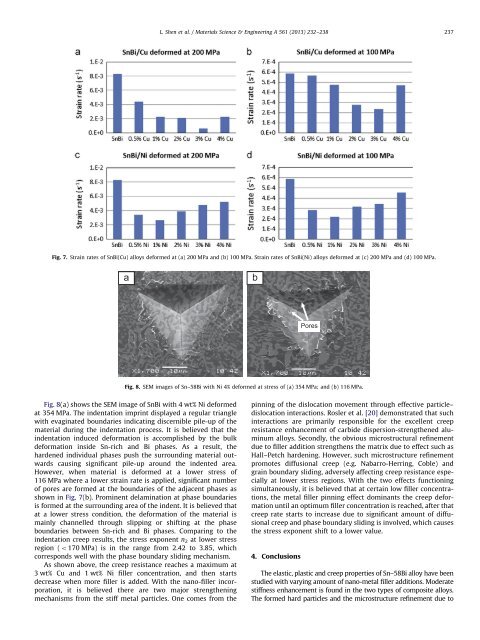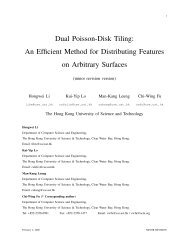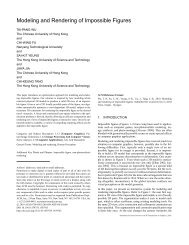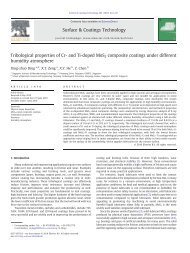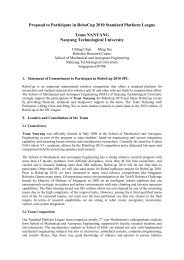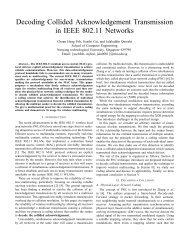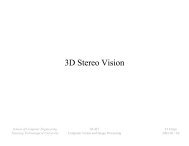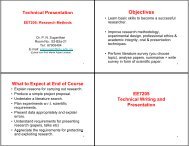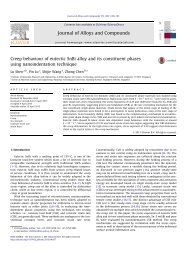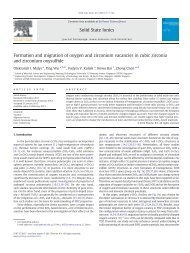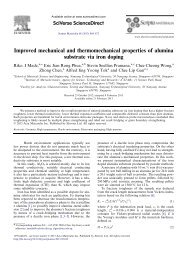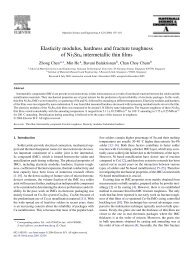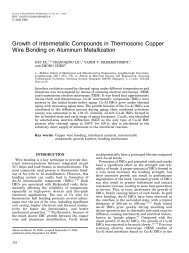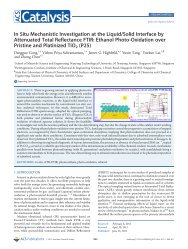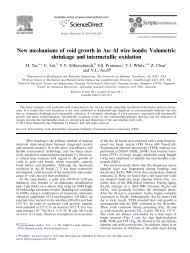Nanoindentation study on the creep resistance of SnBi solder alloy ...
Nanoindentation study on the creep resistance of SnBi solder alloy ...
Nanoindentation study on the creep resistance of SnBi solder alloy ...
You also want an ePaper? Increase the reach of your titles
YUMPU automatically turns print PDFs into web optimized ePapers that Google loves.
Fig. 8(a) shows <strong>the</strong> SEM image <strong>of</strong> <strong>SnBi</strong> with 4 wt% Ni deformed<br />
at 354 MPa. The indentati<strong>on</strong> imprint displayed a regular triangle<br />
with evaginated boundaries indicating discernible pile-up <strong>of</strong> <strong>the</strong><br />
material during <strong>the</strong> indentati<strong>on</strong> process. It is believed that <strong>the</strong><br />
indentati<strong>on</strong> induced deformati<strong>on</strong> is accomplished by <strong>the</strong> bulk<br />
deformati<strong>on</strong> inside Sn-rich and Bi phases. As a result, <strong>the</strong><br />
hardened individual phases push <strong>the</strong> surrounding material outwards<br />
causing significant pile-up around <strong>the</strong> indented area.<br />
However, when material is deformed at a lower stress <strong>of</strong><br />
116 MPa where a lower strain rate is applied, significant number<br />
<strong>of</strong> pores are formed at <strong>the</strong> boundaries <strong>of</strong> <strong>the</strong> adjacent phases as<br />
shown in Fig. 7(b). Prominent delaminati<strong>on</strong> at phase boundaries<br />
is formed at <strong>the</strong> surrounding area <strong>of</strong> <strong>the</strong> indent. It is believed that<br />
at a lower stress c<strong>on</strong>diti<strong>on</strong>, <strong>the</strong> deformati<strong>on</strong> <strong>of</strong> <strong>the</strong> material is<br />
mainly channelled through slipping or shifting at <strong>the</strong> phase<br />
boundaries between Sn-rich and Bi phases. Comparing to <strong>the</strong><br />
indentati<strong>on</strong> <strong>creep</strong> results, <strong>the</strong> stress exp<strong>on</strong>ent n 2 at lower stress<br />
regi<strong>on</strong> (o170 MPa) is in <strong>the</strong> range from 2.42 to 3.85, which<br />
corresp<strong>on</strong>ds well with <strong>the</strong> phase boundary sliding mechanism.<br />
As shown above, <strong>the</strong> <strong>creep</strong> <strong>resistance</strong> reaches a maximum at<br />
3 wt% Cu and 1 wt% Ni filler c<strong>on</strong>centrati<strong>on</strong>, and <strong>the</strong>n starts<br />
decrease when more filler is added. With <strong>the</strong> nano-filler incorporati<strong>on</strong>,<br />
it is believed <strong>the</strong>re are two major streng<strong>the</strong>ning<br />
mechanisms from <strong>the</strong> stiff metal particles. One comes from <strong>the</strong><br />
L. Shen et al. / Materials Science & Engineering A 561 (2013) 232–238 237<br />
Fig. 7. Strain rates <strong>of</strong> <strong>SnBi</strong>(Cu) <strong>alloy</strong>s deformed at (a) 200 MPa and (b) 100 MPa. Strain rates <strong>of</strong> <strong>SnBi</strong>(Ni) <strong>alloy</strong>s deformed at (c) 200 MPa and (d) 100 MPa.<br />
pinning <strong>of</strong> <strong>the</strong> dislocati<strong>on</strong> movement through effective particle–<br />
dislocati<strong>on</strong> interacti<strong>on</strong>s. Rosler et al. [20] dem<strong>on</strong>strated that such<br />
interacti<strong>on</strong>s are primarily resp<strong>on</strong>sible for <strong>the</strong> excellent <strong>creep</strong><br />
<strong>resistance</strong> enhancement <strong>of</strong> carbide dispersi<strong>on</strong>-streng<strong>the</strong>ned aluminum<br />
<strong>alloy</strong>s. Sec<strong>on</strong>dly, <strong>the</strong> obvious microstructural refinement<br />
due to filler additi<strong>on</strong> streng<strong>the</strong>ns <strong>the</strong> matrix due to effect such as<br />
Hall–Petch hardening. However, such microstructure refinement<br />
promotes diffusi<strong>on</strong>al <strong>creep</strong> (e.g. Nabarro-Herring, Coble) and<br />
grain boundary sliding, adversely affecting <strong>creep</strong> <strong>resistance</strong> especially<br />
at lower stress regi<strong>on</strong>s. With <strong>the</strong> two effects functi<strong>on</strong>ing<br />
simultaneously, it is believed that at certain low filler c<strong>on</strong>centrati<strong>on</strong>s,<br />
<strong>the</strong> metal filler pinning effect dominants <strong>the</strong> <strong>creep</strong> deformati<strong>on</strong><br />
until an optimum filler c<strong>on</strong>centrati<strong>on</strong> is reached, after that<br />
<strong>creep</strong> rate starts to increase due to significant amount <strong>of</strong> diffusi<strong>on</strong>al<br />
<strong>creep</strong> and phase boundary sliding is involved, which causes<br />
<strong>the</strong> stress exp<strong>on</strong>ent shift to a lower value.<br />
4. C<strong>on</strong>clusi<strong>on</strong>s<br />
Pores<br />
Fig. 8. SEM images <strong>of</strong> Sn–58Bi with Ni 4% deformed at stress <strong>of</strong> (a) 354 MPa; and (b) 116 MPa.<br />
The elastic, plastic and <strong>creep</strong> properties <strong>of</strong> Sn–58Bi <strong>alloy</strong> have been<br />
studied with varying amount <strong>of</strong> nano-metal filler additi<strong>on</strong>s. Moderate<br />
stiffness enhancement is found in <strong>the</strong> two types <strong>of</strong> composite <strong>alloy</strong>s.<br />
The formed hard particles and <strong>the</strong> microstructure refinement due to


